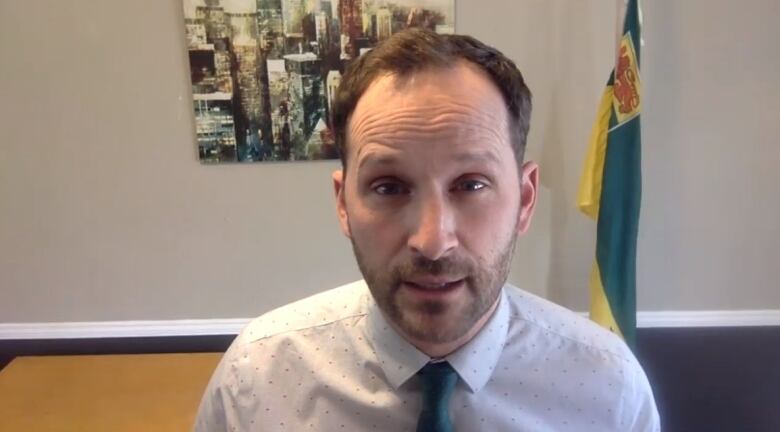COVID-19 in Sask: 1 new case, nearly 75% of all infected people now recovered
'If you have no new cases for two weeks, you must be in the clear,' Colin Furness says

Click here for the latest:COVID-19 in Sask: People reminded again to seek urgent care if needed
- Saskatchewan now has 305 COVID-19 cases, up by one since Wednesday.
- Seventy-two per cent of infected people in the province have now recovered.
- No patient has been in intensive care in the province for several days.
- A Saskatchewan woman is strugglingto learn details of father's death in a Montreal care home.
- Here's how non-profits are faring during the pandemic.
Saskatchewan continues to post low daily increases for new COVID-19 cases, with only one new infected person reported by health officials on Thursday.
Significantly, the one new case was eclipsed by another 14 people who have recovered from the virus.
To date, 72 per centof Saskatchewan's 305 COVID-19 patients have subsequently tested negative for the novel coronavirus.
There have been no hospital patients under intensive care for several days in a row.
But the province is not yetin the clear, one infection control expert says.
Colin Furness, anassistant professor at the University of Toronto, saideven if the province went a whole week without any new cases,"I'm not sure I would break out the champagne."
Furness said the province would need two weeks of zero cases before he'd consider it to be in the clear, and only if testing rates remain steady.
Here's how Saskatchewan's COVID-19 cases break down as of the latest case numbers on Thursday. Note the increasing gap between active cases (red) and recoveries (yellow).
Saskatchewan has not yet had a day with zero new reported infections since the first case was found in the province, though Thursday and Monday came close, with only one new case each.
The province's health apparatuswhich has already expanded its criteria to allow for testing of symptomatic people who have not recently travelled is hoping to even further ramp-up testing, with a goal of testing 1,500 people a day by the end of April.
Furnesssaid that as more people get tested, the greater the chance of more new positive cases including asymptomatic people.
"Ramping up testing typically means finding more cases," he said.
Here's how Saskatchewan's 305 cases break down regionally, according to the latest figures provided on Thursday.

Asymptomatic testing
Saskatchewan's chief medical health officer, Dr. Saqib Shahab, was asked Wednesday about broadening testing criteria in order to track downasymptomatic carriers.
He said the province might consider asymptomatic testing if there's in an outbreak in a long-term care home. No such patients have tested positive so far.
"Just to clarify at that point in time, who is infectious? Who is not? And then you can cohort people within the institutional setting," he said.
The province is not hesitating to test some workers, he added.
"For essential workers that are providing direct patient care,the threshold for testing is extremely low," Shahab said. "If you're a health care worker, even a slight cough, you'll get tested because the last thing you want is transmission to happen in that setting."

Saskatchewan NDP Leader Ryan Meili said that if the province is testing everyone with symptoms and those numbers are going down,that could be good news.
"At the same time, that may give us an opportunity to expandtesting to more health care workers," Meili said during his daily news conference Thursday.
"The last place we want to see this pop up is ina shelter."
Provincial travel plan, rapid testing are key
Furnesssaid it's important for provinces seeingcases slow down to have a plan for when people begin travelling again.
Otherwise, "you're always going to have new cases just walking into the provinces," he said."So even if there isn'tcommunity spread right now, you're only two weeks away from someone spreading a lot around."
Rapid testing is key, Furness said.
"In the ideal world, you would get tested before you got on the plane," he said. "I can also see that at land crossings.It wouldn't be time-consuming, but it means part of driving across the border means parking in a holding area for half an hour to an hour to get the swaband get the results back."
Earlier this week, Premier Scott Moe said Saskatchewan has ordered thousands of rapid test kits and is even eyeing testing models not approved by Canadian regulators.
Why testing in Sask. is down
Moe andShahab spoke earlier this week about why the daily number of COVID-19 tests in the province has decreased recently, despite the goal of ramped-up testing.
"My understanding is that the requests have actually been down," Moe said Wednesday, two days after the Easter long weekend.
While the number of tests per day averaged 750 last week, the closest the province has previously come to its new testing goal was on April 8, when 1,051 tests were conducted.
Since then, daily testing dipped over several daysto 478 on Easter Monday. It increasedslightly on Tuesday to 625, and again to 662 by Thursday,but still remainedwell below the 1,500-a-day benchmark.
Slowed travel, end of flu season cited
Shahab offered additional reasons for the recent dip, which has accompanied a similar decrease in the number of new COVID-19 cases.
"What we saw four to six weeks ago was a lot of travel into the country," Shahab said."So there wasa large volume of testing generated by people who are coming in."
By this week, the number of travel-related cases came to a standstill.
"And then, of course, as we enhanced our testing guidelines and flu season was still happening, there were obviously a lot of people with coughs, colds who were getting tested even if they had not traveled."
It's not whether the number of tests are high or low that matters, he added.
"There should be a proper testing," Shahab said.
Extra capacity may come in handy later: premier
The extra testing capacity is good to have anyway, Moe said.
"We may need that capacityin the weeks and months ahead. And so we want to continue to ensure that we do have that capacity," he said.
Fewer than two per cent of those tested in Saskatchewan have had the virus, Shahab said.
By comparison, Quebec and Ontario have reported positive-test rates of nine and six per cent, respectively.












_(720p).jpg)


 OFFICIAL HD MUSIC VIDEO.jpg)
.jpg)



























































































